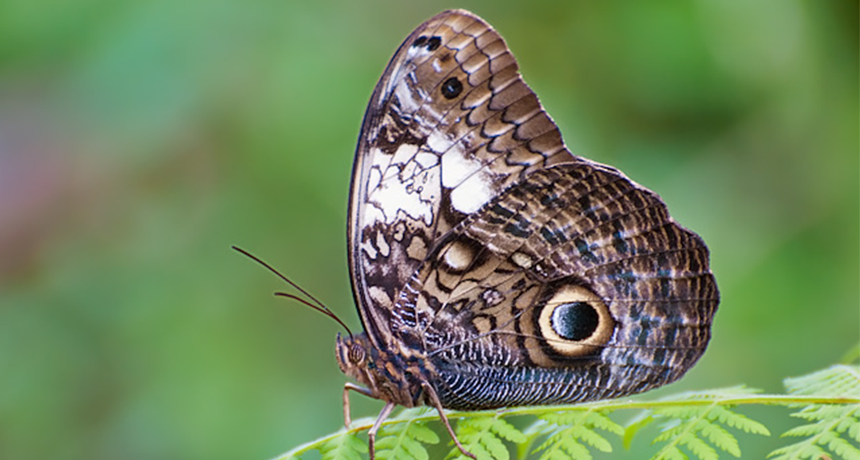
SCARY SPOT The owl butterfly, sporting some of the more eyelike spots on its wings, stars in a new wave of rigorous testing for the old saw that the spots resemble scary predator eyes.
Cláudio Dias Timm/Flickr (CC BY-NC-SA 2.0)
Big spots on butterfly wings actually can mimic the eyes of predators, a new study finds, reviving a partly discredited textbook truth with fresh evidence.
In lab tests, images of butterflies with big spots on their wings spooked hungry little songbirds about as much as images of real, predatory owls did, says Johanna Mappes of the University of Jyväskylä in Finland. Yet butterfly images were only about half as likely to startle the birds when researchers removed the eyespots or reversed their colors, Mappes and colleagues report April 8 in Proceedings of the Royal Society B.
The experiment shows that conspicuous contrast by itself doesn’t give these wing spots their shock value, Mappes says. If the effect is instead due to a resemblance to predators’ eyes — an old and now disputed idea — that advantage could have nudged along the evolution of more realistic eyespots on wings.
The new study “is by far the most convincing evidence that eyespots can work by mimicking eyes,” says Martin Stevens of the University of Exeter in England.
These big round spots with concentric rings stare out of fish tails, caterpillar rumps and plenty of other flesh in the animal world. Flashing the spots in the face of an attacking predator can cause an instant of consternation sometimes just long enough for prey to dodge away.
The basically untested idea that eyespots evolved as mimics of vertebrate predator eyes dominated discussions of spot evolution for at least a century, Mappes says. Then, starting in 2005, came a string of critiques by Stevens. “He had a very good point that we should not assume something is true even if it looks as if it is,” Mappes says.
Stevens and his colleagues had tested the mimicry idea by setting out bits of paper as prey with spots tweaked in shape, color, number and other features to vary the drama of their looks and their resemblance to vertebrate eyes. The more eyelike features didn’t prove important in scaring birds away in his experiments. “We never found any evidence in favor of eye mimicry, but lots to show that conspicuousness does matter,” Stevens says.
Just by being showy, spots might flummox a predator with a split-second of sensory overload, a shiver of doubt at similarity to bold warning patterns or merely aversion to something new. To try to distinguish effects of showiness from mimicking scary eyes, Mappes and her colleagues developed tests based on computers and mealworms.
At a research station in Finland, the researchers conscripted 97 wild birds called great tits (Parus major) for temporary stints in a small cage with a mostly covered computer screen as the floor. A short length of plastic pipe rose from the floor. A bird perching on the rim would peer down inside the pipe at a real mealworm lying on a clear window with a view of the computer screen below. Just as the bird reached for the snack, the computer would flash an image of either an owl or a butterfly behind the mealworm as suddenly as an attacked butterfly spreads its startling wings. The butterfly images Mappes used came from an owl butterfly (Caligo martia) with eyespots that have an unusually vivid resemblance to a real owl’s eyes, she says. This setup allowed for sudden, more realistic deployment of eyespots than in many previous experiments.
The sudden sight of the owl face with its eyes wide open or the natural eyespots sent some of the birds darting to the edge of the cage. Birds that saw fake-looking or spotless wings were less likely to flee.
Stevens applauds Mappes’ study but adds a note of caution. “Something like 10 studies recently have tested the eye-mimicry theory, with most either finding evidence for conspicuousness instead, or producing ambiguous results,” he says. Documented mimicry effects, like those in Mappes’ paper, are unusual, so “it would be premature to conclude that alleyespots mimic eyes.”
Ullasa Kodandaramaiah, of the Indian Institute of Science Education and Research Thiruvananthapuram in India, suggests a middle ground. “Instead of asking whether eyespots are effective due to eye-mimicry or conspicuousness, it might be more fruitful to accept that both are important,” he says.Future research could move on to tracing the patterns of when scary eyes matter and when just big and bold is startling enough.






